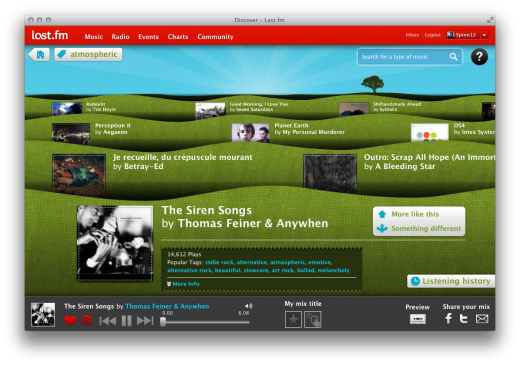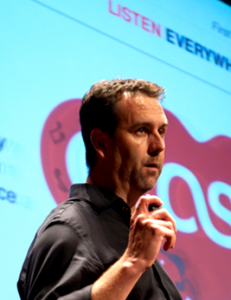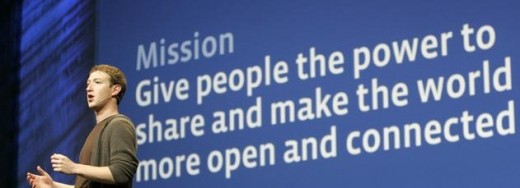
In case you’ve not seen the news , I’ll fill you in. Last.fm has partnered with Microsoft to bring about an incredibly slick HTML5 site, called Discover. Aimed solely at discovering Last.fm’s near-bottomless pool of unsigned artists, it’s a slick, unique interface that is as much a joy to use as it is to see the results.

Once you’ve found something that you like, you can of course Love it (or ban it if you hate it), but you can also drag the cover art into the bottom bar to create a mix that can then be shared via Facebook, Twitter or email. All said, the site is not only fun, it’s incredibly useful. Heck, I found out today that I have a penchant for Newgrass, a fact that I’d have been unlikely to find otherwise.
 But a recent talk that I had with Last.fm’s VP of Product Matthew Hawn led us down a completely different road than where we had initially planned, and it now gives us a sneak peak as to what’s next for the Internet’s behemoth music discovery service.
But a recent talk that I had with Last.fm’s VP of Product Matthew Hawn led us down a completely different road than where we had initially planned, and it now gives us a sneak peak as to what’s next for the Internet’s behemoth music discovery service.
We first talked about Facebook, since the changes to the online music landscape have been dramatic after this year’s f8 conference. What’s most notable about things as they stand today is that Spotify has seen absolutely dynamic growth, and now Last.fm can integrate directly with the new Spotify Apps platform, thereby bringing at least some of that growth to Last.fm as well.
But is Last.fm ready for a traffic deluge? According to Hawn, “we’ve planned for catastrophic success”. That success, interestingly, doesn’t involve Facebook directly.
“We thought about it. What if we put your scrobbles into Facebook? We’re not sure that’s what users want. We’re aggregating from multiple sources. Throwing that into Facebook builds value for Facebook, but what does it give the user? If the answer is ‘you’re sharing with your friends’, it’s not enough of a payoff.”
To that end, Hawn isn’t much of a fan of Facebook’s so-called “frictionless sharing.” Sharing is implicit, says Hawn. It’s what humans do. But in having applications share for you it invariably raises the signal to noise level, and that’s where Last.fm thinks that it should shine.
So the company is going to start flexing what it does very well – data. But not just the data that’s inside of Last.fm. Hawn says that SEO is also going to play an important role, stating that “our SEO rocks. We haven’t supported that in the past, but we’re going to start asserting it. It’s time for us to be a design and product organization, instead of an engineer-led organization.”
What does that mean for the listener? A number of things, but here are some interesting points that Hawn had to make:
- Your Last.fm ID – It should be a guide to the music on the Internet, wherever you go
- Local file playback via the Last.fm mobile app is coming
- Expect to see changes in the subscription vs. ad-supported products of Last.fm
- The site is looking at ways to allow you to purchase music directly from it
- Location and tag filtering should be coming to Last.fm charts
But again, even these are just hints at the bigger picture, according to Hawn. Understandably, he couldn’t go into heavy detail, but even the things he could talk about (some of which I can’t write about, just yet) are highly impressive displays of where Last.fm should be instead of where it has been.
So yes, do check out Last.fm’s Discover app. In conjunction with Microsoft, the two have come up with something that’s really a stellar experience to use. But as you’re using it, finding new tracks, loving them and adding them to collections, bear in mind that there’s a bigger picture still to be seen, and the company is just starting to put the finishing touches onto the first pages of the book.
Get the TNW newsletter
Get the most important tech news in your inbox each week.
